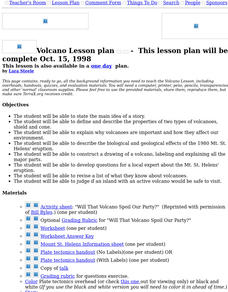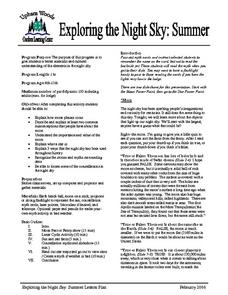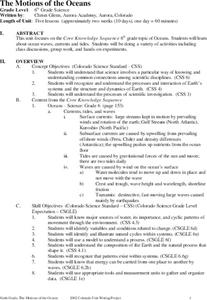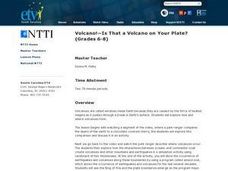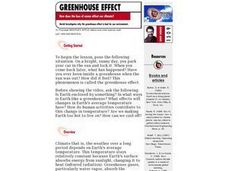Curated OER
Breaking it Down
Students discover how water expands when frozen during a glacier. In this matter instructional activity, students fill a glass jar with water, leaving no room for air in the jar and place it in the freezer. Students retrieve the jar and...
Curated OER
Food Chains
Students create their own food chains on Kidspiration starting from the energy of the sun and what it creates. In this food chains lesson plan, students learn about how insects eat plants and so on.
Curated OER
Volcano Lesson Plan
Students describe the properties of volcanoes, and explain why volcanoes are important to the environment.
Curated OER
Air Quality and Transportation in the Tulsa Area
Students investigate the effects of air pollution. In this environmental lesson, students discuss the causes of air pollution and identify how transportation has an effect on the air quality. Students identify other alternatives to driving.
Curated OER
Exploring the Night Sky: Summer
Students explain how moon phases occur. They describe and explain at least two common misconceptions that people have about the moon. Students explain what a star is. They explain 3 ways that the night sky has been used throughout history.
Curated OER
The Solar System: Go Green with the Sun!
Third graders learn how to use solar power. In this sun, technology and energy instructional activity, 3rd graders learn how the solar power from the sun can give off energy, learn about solar panels, discuss their uses and benefits,...
Curated OER
Life in a Cup
Third graders make and maintain a mini terrarium. They keep a daily journal of what happens in their terrarium and record daily observations and measurements.
Curated OER
Retrograde Motion
Students study the motions of the heavenly bodies. In this space lesson plan students use models to show a variety of schemes explaining the motions.
Curated OER
The Motions of the Oceans
Students examine the topics of ocean waves, currents, and tides. They locate and label ocean currents on a world map, conduct experiments, analyze key vocabulary, view demonstrations and record the data, and complete handouts.
Curated OER
Tides & Lunar Cycles
Students demonstrate how the moon affects the tides, a neap tide, and spring tides by using their bodies as models. After students observe the model they created, they draw and label the diagram on a provided worksheet. They then log...
Curated OER
Volcano! Is That a Volcano on Your Plate?
Students investigate where volcanos come from. In this volcano lesson, students watch videos do Internet research and participate in experiments to discover the cause of volcanos.
Curated OER
Cloud Fun
Young scholars observe cumulus clouds. In this weather lesson, students go outside to look at cumulus clouds and observe what the weather is like when they find these types of clouds. They create a cumulus cloud in an art project and...
Curated OER
Let the Sun Shine!
Students investigate how the sun can be used for energy. They read a handout, discuss the pros and cons of passive solar building design, develop flashcard questions, and identify jobs that can be helped by solar energy.
Curated OER
Fossil Fuels (Part II), The Geology of Oil: Topographic Mapping, Crustal Deformation, Rock Porosity, and Environmental Pollution
Students review an interpretation of geologic history and relate it to the formation of oil deposits. They explore and explain factors controlling the porosity and permeability of sediments and sedimentary rocks. Pupils also interpret...
Curated OER
Earthquakes and Volcanoes
In this earthquakes and volcanoes learning exercise, students use an on line source to answer questions about earthquakes around the world, the origins of volcanoes and the creation of lava tube caves.
Curated OER
What Shape is the Moon Tonight?
Learners understand that the moon appears differently throughout the month. In this phases of the moon lesson, students observe and record the phases of the moon.
Curated OER
How Does the Loss of Ozone Affect Our Climate
Students explore the greenhouse effect and what it does to the environment. They discuss if and how human behavior contributes to global warming and test natural materials for carbon content.
Curated OER
soil, Water, and Plants
Students examine the relationship between water retention and plant growth by conducting two experiments. They first compare the water retention qualities of clay, sand and loam soil types. Then they use the data from the first...
Curated OER
Analog Forecasting
Students recognize the elements of an analog weather forecast. In this weather forecasting instructional activity, students use a website and look for trends, persistence and climatology in weather forecasting. Students complete a...
Curated OER
Measuring Temperature
Students conduct an experiment using the steps of the scientific method. In this scientific method lesson plan, students experiment with temperature and record their findings using the scientific method. Students complete a data sheet...
Curated OER
Sunspots
Students examine what a sunspot is and how it is produced. For this sun lesson students locate and measure sunspots then view them through a camera.
Curated OER
Lakes and Ponds
Students describe and recognize the difference between a lake and a pond. They name six ways in which a lake or pond can be formed. They describe the importance and act of evaporation on a waterway.
Curated OER
Timeline of Extreme Weather Events
Students research and chart extreme weather events on a timeline. In this extreme weather lesson plan, students interview older people who have experienced extreme weather events. Students complete a worksheet based on the information of...
Curated OER
Jackie Gore
Students identify the amount of heat given off by solar energy. In this solar energy lesson, students complete an experiment using soil and sand measuring the heat from solar energy.




